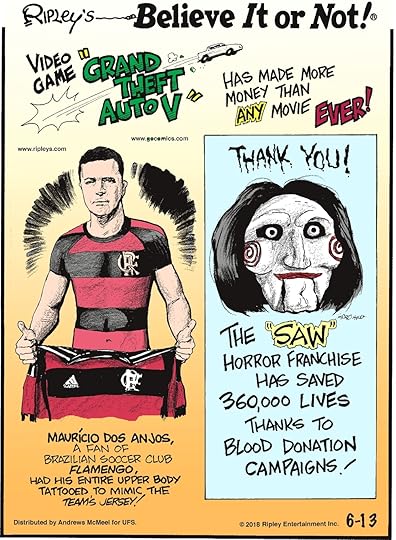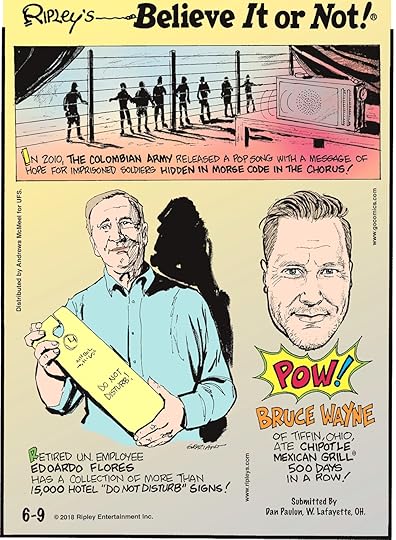Ripley Entertainment Inc.'s Blog, page 338
June 13, 2018
CARTOON 06-13-2018
June 12, 2018
Psychograph: The Pseudoscientific Phrenology Machine
Featured in Ripley's Believe It or Not!
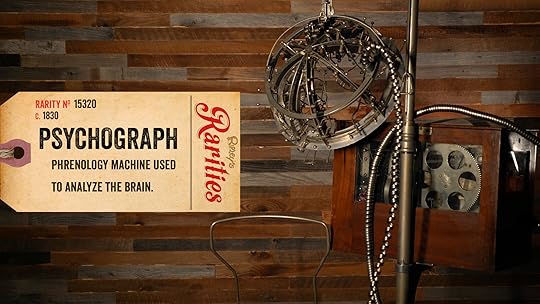
Phrenology has been called pseudoscience, quackery, and fringe. During the 1800s, however, the study of the bumps on a person’s head was fast becoming the explanation for human behavior.
Franz Joseph Gall claimed to discover phrenology in 1796. He saw the brain as not just one complete organ, but the collection of many different pieces that made up the human psyche. He asserted that the human head was filled with 27 distinct organs that determined personality. Animals, of course, only had 19—inferior to our own intellect.
By 1850, phrenology had gained mainstream attention from doctors and intellectuals around the country and was used to explain all manner of brain injuries and mental disorders. The American Phrenological Journal published indexes each organs purpose alongside other quack medicines like animal magnetism. Their complete list included everything from suavity, constructiveness, and wit to stranger sublimations of our idea of time, hope, and even weight.
The road to discovering where all these zones were, and what they meant, was fraught with bad science. A main tenant of phrenology was that the skull grew over the brain during early childhood development. They contended that the bone shaped itself around the brain, mirroring the “organs” inside. Organs that were bigger than average were thought to be stronger or more powerful. They also believed that the skull replicated the topography of the brain, and could be used as a direct indicator of a person’s brain.

The Psychograph
After a series of dissections and a smattering of head measurements on practically random people, phrenologists settled on a scale for brain organs. George Combe—a figure responsible for the widespread acceptance of phrenology—reconciled a possible rift between the pseudoscience and religion by arguing that no zone was inherently evil or bad, but instead the ratings ranged from “deficient” to “very superior.”
Built in Minneapolis, Minnesota, during the 20th-century, two psychographs remain in the Ripley’s collection. These machines would have been set up in doctors offices, malls, theaters, and at fairs as an equivalent to today’s public blood pressure machines. They allowed anyone who was brave enough to put on the uncomfortable metal and wire helmet to print out their very own phrenology profile.
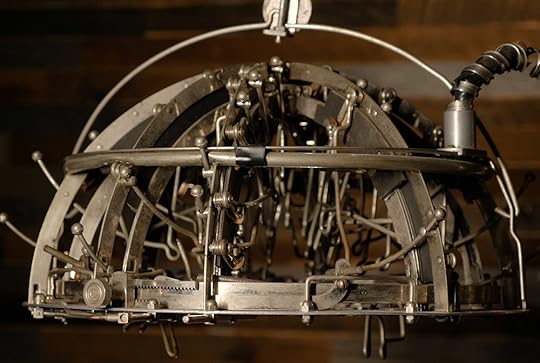
The helmet looped over the ears and was cranked tight around the patient’s head. The metal wires pivoted to match the shape of their skull and copper wires completed circuits at varying degrees of elevation. Once the device was turned on, it would electrify the head cage and take a reading. In just a short while, it would compute your scores and give you a print out to take away with you. Believe it or not, these devices were common in the United States until the 1930s!
Source: Psychograph: The Pseudoscientific Phrenology Machine
5 Weird Americanisms And Their Origins
Featured in Ripley's Believe It or Not!

Have you ever paid attention to the things we say? My neck of the woods? Shooting the breeze? Riding shotgun? They’re such timeworn clichés, we rarely consider what we’re actually saying or where these expressions come from…
But if you’re learning English as a second language, or you have small children, you know that these turns of phrase can really complicate a situation, especially if speakers don’t understand them thoroughly. Or, they take them too literally. What shotgun? Which beans?
English is a colorful language—on both sides of the pond. So, we thought we’d take a look at five popular idioms, their origins, and whether or not they can be blamed on America.
My Neck of the Woods
“My neck of the woods” gets thrown around in casual conversation without a second thought. But it has nothing to do with a forested area, let alone the human body. It refers to your neighborhood, area, or region—the place where you feel comfortable and at home. So, how in the heck did a part of the human body come to refer to your hood?
We know that around 1555, English speakers used “neck” to describe a variety of narrow or constricted things including the fingerboard of a stringed instrument, the upper half of a bottle, a mountain pass, or an inlet of water. Whether or not America’s first colonists continued the tradition remains speculation.
Another theory? According to Bill Bryson’s Made in America, the “neck” part of the phrase actually comes from the Algonquian word niaick meaning a “corner or point.” Algonquian refers to the North American native language group that includes the dialects of the Cree, Ojibwa, Blackfoot, Arapaho, Fox-Sauk-Kickapoo, and Cheyenne. This theory places “my neck of the woods” squarely in the category of an Americanism.

Stomping Ground
When you talk about your favorite “stomping ground,” you’re referring to the place you like to hang out. Your favorite haunt. But where does this phrase originally come from? And is it an Americanism at all?
“Stomping ground” actually started out as “stamping ground” and first appeared in British English around 1820. So, what in the world was a “stamping ground”? A “stamping ground” originally referred to trampled down depressions in vegetation—a place where animals bedded down for the night.
So, how did the “a” become an “o”? Well, you can blame that on Americans. By the 1850s, stamping had become stomping, according to American-speak. While both versions of the phrase are still in use, the “o” version definitely reigns supreme. I guess you could say it’s really stomped the competition? Ouch!

Shoot the Breeze
Can’t stop chatting aimlessly? Then, you’re a master of “shooting the breeze.” It shouldn’t come as too much of a surprise that an idiom that alludes to pointless target practice originated in the American West.
After all, what better way to pass the time than by shooting at nothing—or, literally—the breeze? Like haphazard target practice, the American West turned talking about nothing for extended periods of time into a fine art form… Heck, frontier newspapermen like Mark Twain and Dan DeQuille made it a mark of literary distinction!

Riding Shotgun
If you have kids, you’ve no doubt moderated numerous disputes about who’s “riding shotgun.” As the phrase suggests, there’s a colorful history behind this idiom—one closely associated with, you guessed it, the Wild West.
“Riding shotgun” once referred to a “shotgun messenger,” a colloquial version of the term “express messenger.” The express messenger had the job of riding next to the stagecoach driver. With a shotgun in hand, he was perpetually prepared to defend the stagecoach from approaching hostiles.
First used in popular media around 1905, the phrase originally meant providing somebody with assistance or aid. But with the advent of automobiles and restless children, a new meaning developed. Today, the idiom comes in most handy during hardscrabble battles to secure the front passenger seat.

Spill the Beans
So, what exactly does dropping food have to do with a broken confidence or divulged secret? One popular theory claims that colored beans were used by secret societies in Ancient Greece for votes about new initiates. Beans were dropped into an opaque jar and then spilled out to count who was and wasn’t voted in as an initiate. Some secret societies still use colored beans to vote to this day, which makes this theory sound promising.
But as Rosemarie Ostler, author of Let’s Talk Turkey: The Stories Behind America’s Favorite Expressions, points out, the colored beans are problematic. In Ancient Greece (prior to First Contact with the New World), the only legumes that grew were fava beans. The same goes for Europe. And fava beans were, as you can imagine, all the same color…
The more likely culprit? William Williamson’s History of the State of Maine describes a vote cast in 1650 using beans and corn. Beans symbolized “yes” votes. Corn meant “no” votes. This theory makes “spilling the beans” firmly an American phrase. But it begs another question. Should the phrase actually be, “spill the beans and corn?”

Weird Americanisms
Idioms, we use them all the time and don’t even think twice about it. They add color to our language imparting cultural meanings that go far deeper than the definitions of the composite words.
What’s even more colorful than these sayings? Their mysterious origins. Some phrases lay claim to being true Americanisms while others are firmly rooted in British-speak. Either way, our language would be far poorer without them.
By Engrid Barnett, contributor for Ripleys.com
CARTOON 06-12-2018
June 11, 2018
This Artist Paints With His Palms
Featured in Ripley's Believe It or Not!

Russell Powell of San Jose, California, stamps his art onto paper after carefully painting his palms.
One day, while teaching art at an elementary school, he began painting on his hands. Fast-forward two and half years later, and he’s created his own art form. A completely self-taught artist, he has refined the process by continuously experimenting. By manipulating his hand—and the way he paints—many different ways, he can carefully control the proportions of figures left by his hands.
Powell has painted an array of subjects, ranging from historical figures and music artists to indigenous peoples and exotic animals. To start, he decides whether he wants the finished product to be in black-and-white or in color. Sometimes he’ll even mix the two styles for a more striking effect.
The hardest part, he says, is incorporating highly detailed features. His painting surface is limited by the size of his hand, and he also has to work around his fingers and palm. He also has to consider how fast the paint will dry once he’s started. Since it has to be ready to adhere to a second surface, he’s had to develop various techniques for the perfect transfer. Though it may be a difficult medium to paint on, his handprint is what gives him such a personal connection to each piece he creates. His fingerprints are literally visible on each piece.
When he wants to expand the size of a handstamp painting, he can stamp various paintings on his hand together on one canvas. He’ll even fill in details and background with partial handprints. Creating expansive landscapes can be difficult, however, as each handprint has to be painted as a mirror image before being stamped.
“There are a lot of causes that need attention, so I try to donate my work and include certain subjects as part of my work to shine a light on issues people need to think about. Hopefully, it can help move the conversation forward and provoke people to talk about some of the things happening around all of us.”—Artist Russell Powell
Powell continues to create art drawing, inspiration from his students. We’ll continue watching his work on Instagram, but you can check out his work along with our growing collection of exceptional artists in our new book, Odd Is Art.
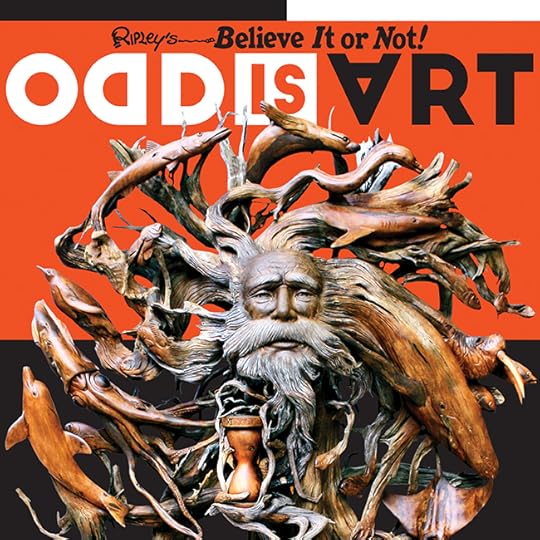
From paintings by an artist with no arms or legs to sculptures made entirely of salt, you’ll find some of the most fascinating and unbelievable pieces of art from the Ripley’s Believe It or Not! collection. Designed as an elegant art book meets the eclectic one-of-a-kind Ripley’s archives and exhibits, Odd Is Art is a visually stunning book that will delight and amaze art lovers and Ripley fans alike.
CARTOON 06-11-2018
June 10, 2018
CARTOON 06-10-2018
June 9, 2018
Florida Woman Sees Jesus On Horseshoe Crab Shell
Featured in Ripley's Believe It or Not!

[June 3-9th, 2018] A severed snake head sends a man to the hospital, a cat turns 30 years old, and a woman sees Jesus on the shell of a horseshoe crab.
30-Year-Old Cat
What many people believe to be the world’s oldest living house cat turned 30 this week! The orange-and-white kitty named Rubble was born in 1988. Rubble lives with his owner, Michele Foster, in the United Kingdom. When asked if her cat was enjoying the attention he’s getting for her birthday, Foster responded that her cat was a private guy and wanted to live out his old age in peace.
Severed Snake Head
A man in Corpus Christi, Texas, was rushed to the hospital and administered 26 doses of anti-venom after being bitten by the severed head of a rattlesnake. He had just beheaded the snake with a shovel when he reached down to pick it up. The head turned and bit his hand, releasing all of its venom. He immediately began having seizures and lost his vision, but doctors were able to quickly treat him, and he’s now recovering.

Ghost Fashion Show
In the midst of its current social reforms, Saudi Arabia has been trying a lot of new things, but a model-less fashion show highlights this dissonance. Previous fashion shows only allowed female audience members, and male designers weren’t even allowed backstage. They seem to have found a way around that by removing the models entirely and using drones to float their dresses across the stage. Some women, however, regard this as a win, saying they have more important things to do than prance on stage.
Saudi arabia fashion show#fashionstyle #fashionshow
A Killer Horoscope: The Murders of French Doctor Marcel Petoit
Featured in Ripley's Believe It or Not!

Believe it or not, horoscopes were once linked to a serial killer…and, no, we’re not talking about The Zodiac!
The Ad
Who wouldn’t want to answer an ad for a personalized, ten-page horoscope advertised as, “Absolutely FREE” in their local paper? The ad went out in a French newspaper on April 16, 1968. All readers had to do was send in their name, address, date, place of birth, and a few tidbits of personal information to receive a custom personality profile. Submissions flooded in and 500 people received their horoscopes. Urged to reply back, many were impressed with the accuracy of their profiles. About 95% claimed they were spot on.
Killer Profile
Despite the seemingly supernatural accuracy, they had been duped. Every respondent was sent the exact same report. The architect of this scam was psychologist Michel Gauquelin, who had commissioned a professional astrologer to do a chart and interpretation of a real person. That person was Dr. Marcel Petiot—one of France’s most notorious serial killers.
Known for taking the lives of over 60 people in wartime France, Marcel Petiot’s story is harrowing. His life of crime began in his teenage years and ran parallel to a successful military, political, and medical career. He was a corrupt doctor, prescribing addictive substances and scandalously having affair with a patient’s daughter.
In 1933, settled in Paris, Petiot established himself as a member of La Résistance. He promised a path to safety and freedom to those leaving Nazi-occupied France. His fees were exorbitant. The few who could afford his 25,000 franc fee—about half a million dollars today—were sorely surprised. Under the guise of inoculating patients against various diseases required to leave the country, Petiot injected them with cyanide, stole all their money, and disposed of their bodies in quicklime, underground, or the Seine river. Pétiot went on trial March 19, 1946 with a total 135 criminal charges. He was convicted of 26 murders—a fraction of the truth—and was sentenced to beheading.
Source: A Killer Horoscope: The Murders of French Doctor Marcel Petoit
CARTOON 06-09-2018
Ripley Entertainment Inc.'s Blog
- Ripley Entertainment Inc.'s profile
- 52 followers


